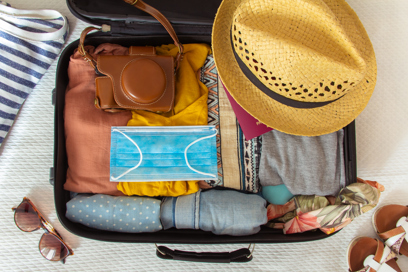There are many benefits to traveling. Taking a vacation can help you de-stress, not think about work and truly relax while you experience an all-new place or culture. Even traveling for school or work can be exciting, as you learn to navigate a new city, and can form long-lasting relationships with the people you meet.
Yet as important as travel is for your mind and spirit, there is no denying that planning for a trip can be a bit stressful. Whether you’re leaving the country for a month, traveling south for the winter or just taking a domestic weekend trip, there are so many little details to remember and bases to cover. Constructing a thorough pre-travel checklist can help you prepare for your trip, and below are some ways to help you stop stressing and start planning.
1. Plan Your Travel With a Pre-Travel Checklist
When it comes to making an itinerary for your trip, sometimes having minimal plans on how to spend your vacation time can be the most relaxing option. However, there are still some preparations you should make before you leave, such as figuring out how far away from the airport your hotel is or how you’ll get around town once you arrive.
Creating an itemized itinerary on the day of your flight, train or drive can help you prepare properly before you leave for your trip. For example, making notes on what time it’ll be locally when you arrive, what documents you might need to take with you (will a driver’s license work, or do you need a passport too?), the layout of the airport or train station and even some common phrases in the local language can all help take some of the stress out of traveling.
Pre-Flight Travel Checklist
Here are some additional tips to keep in mind when planning your travel:
- Before booking your trip: Research your destination for any potential health or safety risks. If you’re traveling internationally, check in with the local US Consulate or Embassy office to let them know you will be in the country for whatever amount of time you’re there. That way if a natural disaster or incident happens, the Consulate will know to look for you and provide you support if you need it.
- 2 weeks before your trip: Research your destination and determine how you’re going to get around (taxi, Lyft, Uber, public transportation, rental, etc.) and how you’re going to get to and from the airport both when you arrive and when you need to leave. Make sure to have a couple of backup options just in case your first one falls through. Leaving for a vacation can be stressful enough, but missing a flight or train is no laughing matter — especially when you’re in a foreign country.
- 1 week before your trip: Make a list of all the things that you need to check or do before you leave the house. This might include paying bills, scheduling a pet sitter, watering your plants, mowing your lawn, notifying your bank of your international trip, downloading your preferred entertainment or simply making sure the house is organized. Add to it as you go along if you remember more things you need to do.
- 24 hours before your trip: When checking into your flight, do you also need to check baggage? Can you check in on your mobile device or computer? There’s certainly pros and cons to checking into your flight early — one positive is that you’ll be able to guarantee your seat on the flight, but a negative is, if flights are delayed, canceled or rescheduled, you may not be able to hop on the next most available flight. Keep these pros and cons in mind as you plan out the start of your trip.
- 3 hours before your trip: How soon should you arrive at the airport before your flight? In the United States, TSA suggests accounting for the time it takes to find parking, find your check-in area, get through security and the time it takes to get to your gate. Depending on the airport you’re using, this can mean showing anywhere from 3 hours to just an hour before your flight. Additionally, keep in mind that some airlines require you to check into your flight at least 30 mins before your flight leaves its gate, although this policy can vary depending on the airline you’re using, as well as the specific airport you’ll be departing from. If you’re anxious about checking in, you can contact TSA (or use their app) to determine how long the security lines are at your airport, and you can contact your airline to get more information on your flight and when you should check-in.
International Travel Checklist
- Get your passport renewed. Make sure your passport is up to date at least six months before you travel. Though last-minute services are available to renew your passport with a quick turnaround, you’ll have to pay a hefty fee and there’s no guarantee that they’ll be able to get your passport in your hands before your flight is scheduled to leave.
- Check your credit cards. Does your credit card or debit card have a foreign transaction fee? The two or three percent fee that some cards charge per transaction can add up quickly and throw your entire trip budget off course. Opt for a card that specifically does not have any fees.
- Research restaurants if you have food allergies. Food allergies or intolerances can make traveling abroad even more stressful than it already is, so do your research ahead of time to make sure you know what restaurants are safe to dine in and where in the city they’re located. It’s inevitable that you’ll end up at restaurants or food stalls that you didn’t account for, so print out a card online that explains, in the language of the country you’re traveling to, what you can’t eat. (Celiacs, for instance, can find gluten-free restaurant cards in 63 languages from Celiac Travel.)
- Be up-to-date on vaccines. Certain countries may require you to get specific vaccines, so be sure to plan those long in advance to ensure that you’re immunized before your trip.
- Get travel insurance. Getting travel insurance may only cost you a few dollars a day, but in the case of an unlikely emergency, it may save you hundreds or even thousands of dollars.

2. Make a Packing List
Before your trip, you should also make a packing list that includes all the essential items you’ll need while on your trip. Keep in mind, that you should always check the expected weather at your destination so you can bring the appropriate clothes to keep you warm or cool. Additionally, make sure to bring any medications with you. If you’re flying, keep these with you in your carry-on, just in case your luggage gets lost or stolen.
Other items, such as a toothbrush, toothpaste, makeup, shampoo, phone chargers and more will most likely be available for purchase in the area that you’re visiting. If you’re trying to save space, or you simply forget an item, you can most likely purchase items when you arrive. However, if you plan on packing them, be sure to keep liquids in a bag in case they leak (pressure changes while flying or driving through mountains can cause packages to burst), and follow all the applicable laws if you’re flying with liquids in your carry on.
| Tip: Though it doesn’t guarantee that a lost bag will turn up, keeping a Tile tracker or Apple Airtag in your checked bag can potentially help you locate any luggage that doesn’t make it to your destination. While you’re packing, write down the items you put into your checked bags (or take a photo of their contents) to make it easier for you to estimate the cost of your belongings if you need to file a claim. Your credit card — especially if it’s a travel rewards card like the Chase Sapphire Reserve — may even give you a daily stipend to buy essentials like clothing and toothpaste if your luggage is lost or delayed. |
3. Pack Your Suitcase Strategically
When it comes to packing, keeping your luggage light can make traveling a lot easier. If you’re worried about space, try slimming down the clothes you bring or consider packing your luggage tightly to conserve space.
One popular packing method is the Konmari method, developed by author Marie Kondo. When it comes to packing your suitcase, following this organizational style can help you save space and avoid overpacking:
- Folding your clothing as small as possible is one of the key aspects of the Konmari method. Typically, items are folded into a rectangle shape and then folded into thirds. Additionally, sheer or light fabrics can be rolled up to prevent wrinkles.
- Keep like items (undergarments, shirts, pants, dresses, etc.) together in your suitcase.
- Use shoe bags or a liner to keep shoes separate from your clothes.
- Only put in your suitcase the things that you really wear, and ask yourself if the things you are bringing “spark joy” for you.
Things to Pack for International Flights
- Compression socks for long flights. Long flights can take a toll on your circulation, especially for those with pre-existing conditions. Compression socks (and compression shirts or other gear) can help prevent swelling and clots as well as keep your blood circulating.
- Portable charger. The last thing you’d want in an unfamiliar country is to be stranded with a dead phone. Bringing along a portable charger can come in handy if you plan on staying outside of your hotel or hostel for most of the day, and can easily slip into a fanny pack or tote.
- Adapters. International travel newbies may find themselves struggling to plug their appliances or devices into the wall in foreign countries. Preventing this requires a simple purchase: adapters/electrical converters.
4. Organize Your Home
Once all your items are packed and your itinerary is set, the only thing left to do before you leave your home for a trip is to ensure your space is neat and organized for when you get back.
This step is certainly optional, but preparing for a trip can provide you with the perfect opportunity to organize your home a little bit. Sometimes taking vacations can leave travelers a bit mentally exhausted, so organizing ahead of time can help ease the stress of returning to normal life. There’s nothing like coming back to a well-organized, clean and comfortable space, so utilize some spring cleaning tips to get your home in order.
If your trip is more long-term — such as leaving for a study-abroad program or an extended stay down south during the winter — then there may be some additional steps that you need to consider. This can include finding boarding for pets, a housesitter, a lawn or garden-care service, or storage for your car to ensure it doesn’t get stolen, broken into, or damaged. Additionally, if you decide to vacate your home or rent it out for a time to offset travel costs, you may need to store your furniture and other personal items in a storage facility. It’s important to research what options are in your area and entrust your items to a reliable storage company.
When you do come back home from your trip, you’ll be thankful that you had the forethought to organize your home before you left. Traveling is exciting, and seeing new places and meeting new people can be especially engaging for your mind, but it can get exhausting quickly, as well.
Wherever you end up going and however you get there, this list should help make your trip just a little less stressful. Happy travels!









